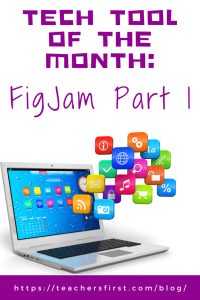FigJam is a versatile online whiteboard that excels at fostering classroom collaboration. Its comprehensive suite of built-in tools, enables groups to brainstorm, draw, paste images, add sticky notes, and organize information visually—all in real time. The platform provides infinite space for adding templates, drawings, and areas dedicated to conversations and projects. Interactive elements like emojis, high-fives, and stamps make collaboration more engaging.
Unlike traditional whiteboards, FigJam is cloud-based, making it accessible from any device—ideal for blended or remote learning environments. Getting started is simple:
- Create an account to access all features.
- Create your FigJam board by clicking the purple +FigJam Board link near the top of the home page.
- Enhance your whiteboard with various tools, including drawing and writing tools, a timer, and an AI generator for creating timelines and mindmaps.
Easily share your FigJam board with others via a link, email, or embedding it on a webpage. FigJam empowers students to capture and develop their ideas in a flexible and intuitive workspace, whether for brainstorming, project planning, or information sharing.
Applying the Triple E Framework
The Triple E Framework, created by Dr. Liz Kolb, believes that “effective technology integration begins with good instructional strategies and not fancy tools” (tripleeframework.com). Dr. Kolb wrote a book, Learning First, Technology Second (ISTE, 2017), which lays out the three main uses of technology in education: to Engage, Enhance, or Extend learning goals. We can use this framework to decipher why we use specific classroom tools. Here is a rubric based on the Triple E Framework you can use to evaluate whether FigJam (or any other technology) is a good fit with your learning goals and whether you should use it in your lesson.
- Engage in learning goals: The students are active rather than passive learners as they create and share mindmaps, timelines, brainstorming ideas, and more in real time on a virtual whiteboard. They are motivated to begin learning and show what they know, as they can add sticky notes, stamps, and other engaging features.
- Enhance learning goals: FigJam creates pathways for students to demonstrate their understanding of the learning goals in a way they cannot do without technology. For example, collaborative learning groups could only work virtually on a mind map in real time with technology.
- Extend learning goals: Dr. Kolb describes extended learning as an opportunity for students to learn, connect, and collaborate outside the regular school day and as a way to create a bridge between school learning and everyday life experiences. FigJam would make a fantastic asynchronous learning experience (if students have been instructed to use this site). FigJam allows students to collaborate virtually in and out of the classroom and build skills they can use in their future and everyday lives (such as collaborating on a team or using their vocabulary to brainstorm and share ideas). Students could need to collaborate with teams, use technology, and demonstrate an appropriate vocabulary in future courses or careers.
SAMR Connection
The SAMR Model, by Dr. Ruben Puentedura, suggests that technology implementation has four levels. Therefore, we can use this model as a guideline to analyze how we use technology tools in the classroom. For example, using FigJam with your students could be at all four SAMR levels, depending on how they use it. Let’s look at an activity where students create a timeline about an invention.
- Substitution: The substitution level is the most basic level of SAMR and refers to when technology acts as a direct substitute without any functional improvements. For example, students could use FigJam to create a timeline rather than write one on paper.
- Augmentation: At the augmentation level, the technology acts as a direct substitute and includes some functional improvements. Our timeline activity can be taken to the augmentation level by having students use the features of FigJam that are not available without technology, such as using AI to create a quick timeline to get started or using features such as virtual sticky notes, adding songs, virtual timers, arrows, and other features that are not available without technology.
- Modification: The level of modification is when the technology allows for significant task redesign. For example, we could modify our FigJam timeline activity by sharing it with classmates and collaborating with a team. This offers a considerable task redesign, as students can view others’ timelines and then comment and add more content.
- Redefinition: At the redefinition level, the technology allows for creating previously inconceivable new tasks. We could take our timeline activity to this level by having the cooperative learning groups share the link to their final FigJam timelines on a more social platform (and with more people), such as the class website, a Google Site, or Padlet, and allowing other students to comment on the timeline.
Take advantage of Part 2 of the Tech Tool of the Month: FigJam, where we’ll discuss using the tool and classroom ideas. In the meantime, let us know how you have used FigJam in your education setting in the comment section below.


